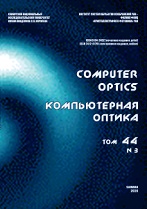|
This article is cited in 1 scientific paper (total in 1 paper)
IMAGE PROCESSING, PATTERN RECOGNITION
Benign and malignant breast tumors classification based on texture analysis and backpropagation neural network
L. M. Wisudawatia, S. Madendaa, E. P. Wibowoa, A. A. Abdullahb
a Faculty of Computer Science and Information Technology, University of Gunadarma, Jl. Margonda Raya No.100, Pondok Cina, Kecamatan Beji, Kota Depok, Jawa Barat, 16424
b Faculty of Medicine, University of Gunadarma, Jl. Margonda Raya No.100, Pondok Cina, Kecamatan Beji, Kota Depok, Jawa Barat, 16424
Abstract:
Breast cancer is a leading cause of death in women due to cancer. According to WHO in 2018, it is estimated that 627.000 women died from breast cancer, that is approximately 15 % of all cancer deaths among women [3]. Early detection is a very important factor to reduce mortality by 25-30 %. Mammography is the most commonly used technique in detecting breast cancer using a low-dose X-ray system in the examination of breast tissue that can reduce false positives. A Computer-Aided Detection (CAD) system has been developed to effectively assist radiologists in detecting masses on mammograms that indicate the presence of breast tumors. The type of abnormality in mammogram images can be seen from the presence of microcalcifications and the presence of mass lesions. In this research, a new approach was developed to improve the performance of CAD System for classifying benign and malignant tumors. Areas suspected of being masses (RoI) in mammogram images were detected using an adaptive thresholding method and mathematical morphological operations. Wavelet decomposition is performed on the Region of Interest (RoI) and the feature extraction process is performed using a GLCM method with 4 statistical features, namely, contrast, correlation, entropy, and homogeneity. Classification of benign and malignant tumors using the MIAS database provided an accuracy of 95.83 % with a sensitivity of 95.23 % and a specificity of 96.49 %. A comparison with other methods illustrates that the proposed method provides better performance.
Keywords:
mammography, CAD system, adaptive thresholding, mathematical morphology, wavelet, GLCM, artificial neural network.
Received: 25.06.2020
Accepted: 22.12.2020
Citation:
L. M. Wisudawati, S. Madenda, E. P. Wibowo, A. A. Abdullah
Linking options:
https://www.mathnet.ru/eng/co901
|

| Statistics & downloads: |
| Abstract page: | 55 | | Full-text PDF : | 26 | | References: | 15 |
|




 Contact us:
Contact us: Terms of Use
Terms of Use
 Registration to the website
Registration to the website Logotypes
Logotypes








 Citation in format
Citation in format 
